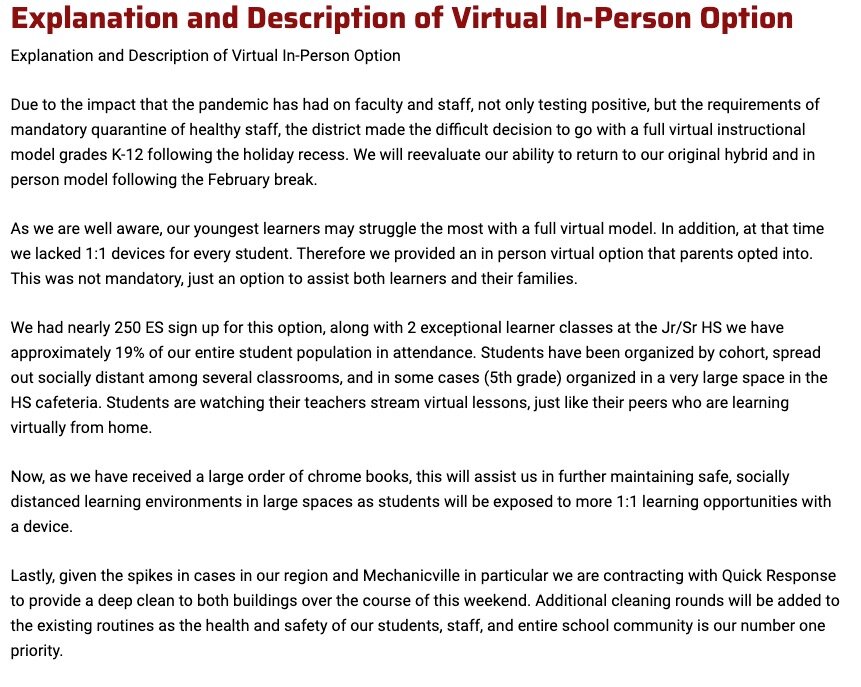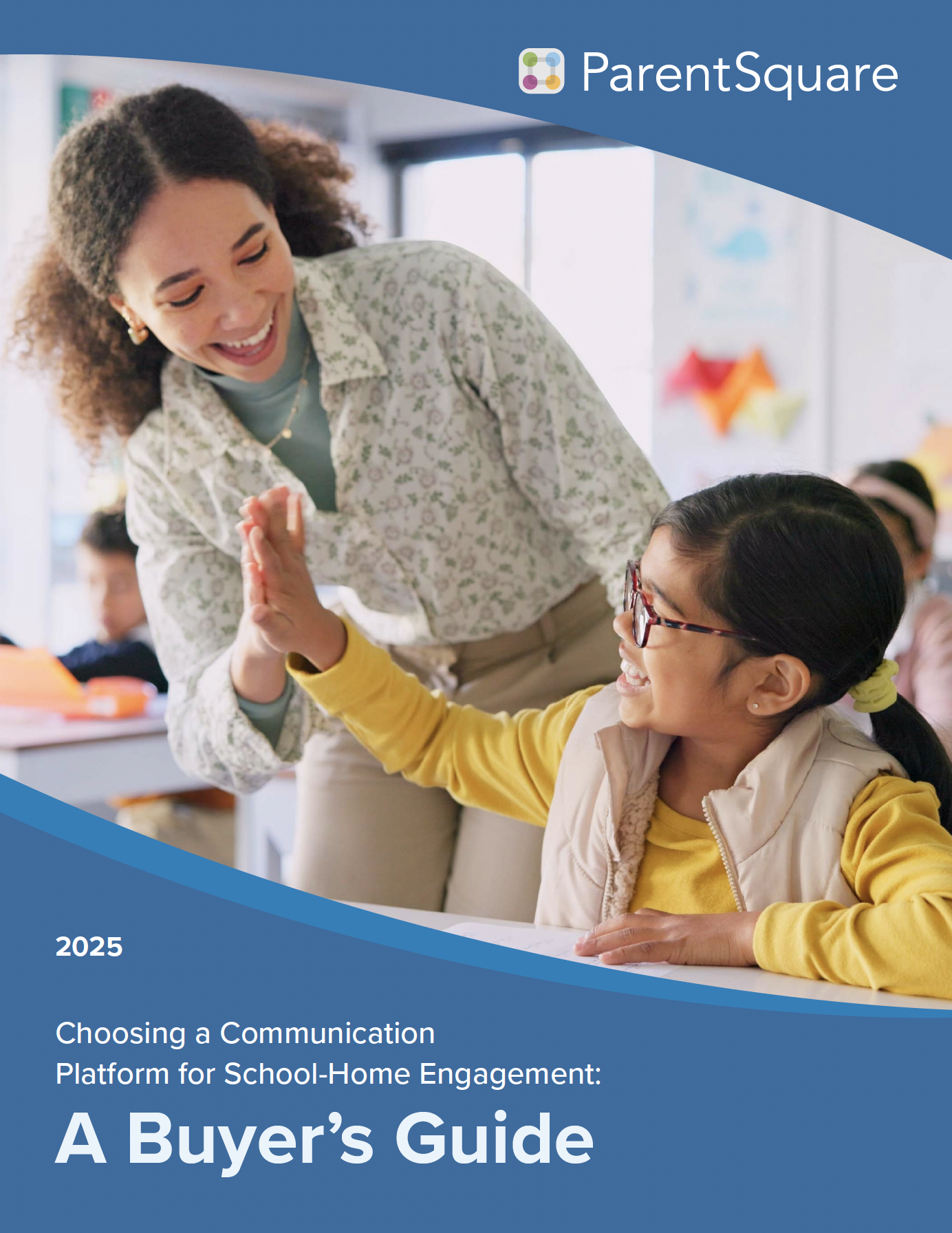
Shifting learning scenarios amid the pandemic poses various challenges for school leaders, students, and their families. How do you continue engaging with and meeting every family’s communication needs with so many unknowns? Is there such a thing as an ideal school-home communications strategy to keep everyone happy and in the loop?
In last month’s webinar, “Principals Speak: Strategies for Creating Meaningful Connections & Engagement with Families,” we spoke with two principals, Nicole Johnston of Cedar Ridge Middle School (Oregon Trails School District, OR) and Mike Mitchell of Mechanicville Jr./Sr. High School (Mechanicville City School District, NY). They addressed various communications challenges their schools faced over the last year and how they successfully dealt with them while keeping parents engaged and informed.
Both offered actionable solutions and ideas to better connect with families, including communicating important changes in learning scenarios. The principals wrapped up the conversation by discussing how schools can connect with the hardest-to-reach families to close the communications equity gap.
Here are seven ways the principals keep families meaningfully engaged, and you can, too, whether your school is remote, in-person, or hybrid.
1. Offer Fun Events for Students
No matter the learning scenario, it’s essential to provide students with social time to connect with peers and have fun. While traditional social activities may not be feasible at this time, there are plenty of remote or hybrid activities that allow students to connect! Here are some community-building activities that worked for Cedar Ridge and Mechanicville:
-
Choose Your Own Adventure: Kids can choose from virtual activities like karaoke, scavenger hunts, or Among Us (a student favorite). Cedar Ridge Middle School found massive success with this activity—75% of students joined virtually! It was an excellent opportunity for students to get some much-needed social time they are otherwise missing out on due to remote learning.


-
Virtual Craft Night: Oregon Trails School District provided students with all of the materials they needed and held a live session to do crafts together. Virtual events, in general, have been hugely successful for Cedar Ridge Middle School. They have more student engagement with remote events than they ever did with on-site events, a true testament to the convenience of technology!
“We started this year really thinking about ways to bring the normalcy to our kids. The things they love, they enjoy, they get from schools. Even though we’re not in person, we wanted to try to find ways to engage our kids… things that would bring our community outside of just our classroom activities.” —Nicole Johnston, Principal, Cedar Ridge Middle School
-
Hybrid Senior Trivia Night: At Mechanicville High, seniors could join a special trivia night in-person or virtually to make sure everyone felt comfortable with the event. 75% of students attended! For those who attended on-campus, school leaders explained the safety protocol beforehand to set expectations. Students happily followed all social-distancing rules and were excited and grateful to have the opportunity to be together again.

2. Meet Families Where They Are & Put Their Needs First
Due to the many challenges raised by the pandemic, every family’s needs are different. It’s important to find out how students and families are willing to engage and accommodate that if possible. Not only does this provide flexibility, but it also helps promote equity by allowing students to participate no matter their situation.
For example, the Hybrid Senior Trivia Night mentioned above was initially supposed to be an in-person event, but some students expressed that they were uncomfortable coming to school. To address these concerns and ensure all students could participate, Mechanicville switched the event to hybrid. Small changes like these make a big impact on overall student participation and morale.
Mike Mitchell shared that when Mechanicville transitioned to remote learning, they recognized that some families needed to have their students go to school in-person (due to work, lack of child care, etc.). To accommodate those families’ needs, the school set up their cafeteria with 70-80 socially-distanced Chromebooks for students to do their virtual learning. While shifting instruction methods are somewhat out of a school’s control, providing options to parents shows them that you are putting their needs first and willing to go the extra mile to ensure continuity of instruction.
Also, Mechanicville families who choose hybrid learning are allowed to switch to virtual learning at any time, if they wish to stop attending on-site. Principal Mitchell explained that students in virtual learning cannot switch at any time, as that alters the numbers in the classroom and puts people at risk. (Virtual learners in elementary and middle school can change their learning scenario option at the end of the trimester, while those in high school can change at the end of the semester.)
“We want to make sure that our parents, our community, is heard; and validate them as an integral part of our school district. And I think that’s really helped build the culture of our school district. It’s shown transparency and helped forge a better culture and climate by engaging all of our stakeholders.” —Mike Mitchell, Principal, Mechanicville Jr./Sr. High School
3. Keep Communications Concise
Make it easy for your parents to get the information they need! Many parents are overwhelmed with the amount of school messaging they receive each day, so it’s unrealistic to expect them to read lengthy messages. Parents are more likely to engage with communications if you keep notices and information to-the-point.
Concise school-home communications don’t mean that you can’t share all of the information parents need; it means you need to deliver it in a way that is easy to absorb. One method for communicating succinctly is by providing shorter messages with key information with a link to more details for those who are ready to dig in and learn more (try posting an excerpt from the weekly newsletter with a link to read more!). Concise messaging also works well for social media platforms, where parents may be accustomed to seeing shorter, at-a-glance messaging on platforms like Twitter, Facebook, and Instagram.
4. Use Multiple Forms of Communication To Reach Everyone
Every family has different preferences for how they like to receive communications, and what works for one family may not necessarily work for another. To ensure that your messaging reaches everyone, consider using multiple communication forms and make a concerted effort to connect with everyone, including your hardest-to-reach families. To do this, you might need to think outside of the box, engage a specialized outreach team, or communicate in a different language. Still, your efforts will give families a better chance of staying engaged and informed and promote communications equity.
So long, email! Here are some alternative ways to stay in touch with families:
-
Post on Social Media: Utilize Facebook, Twitter, and Instagram to get your information out there! Many parents and students already have accounts they check daily, so they’re likely to see and engage with school posts. Don’t be afraid to ask parents to follow your school or district’s social media accounts!
Note: You can share to social media easily using ParentSquare’s Social Sharing feature!
-
Safely Visit Students In-Person or Set up 1-1 Virtual Meetings: During remote learning scenarios, some students may not be receiving or checking virtual communications or may feel like the school does not care about their success. Taking the extra step to reach out personally can make a huge difference. Students know that they always have a trusted adult to depend on, even if they aren’t physically at school. A safe in-person visit also ensures that families who don’t have access to technology or aren’t comfortable using it still receive information and engage with school personnel.
“They need to know that we’re there for them. I’m their principal, but I’m also their advocate and someone who cares about them.” —Mike Mitchell, Principal, Mechanicville Jr./Sr. High School
-
Check-in With Periodic Principal Meetings: Mechanicville holds a coffee chat at least once a month before their Board of Education meeting to talk about any school/district changes, updates to learning scenarios, and issues that need to be addressed. These meetings give parents a platform to express their concerns, get questions answered, and clarify information before it goes to the Board. Principals and school leaders stay until they answer every question to ensure every parent feels heard.
-
Try a Phone Call: A simple phone call can be an excellent way to engage in a meaningful way with families. Also, a call is often more efficient and shows parents that you care enough to take the time to reach out to them personally. Principals can request teachers set aside time each week to call a few families for a quick check-in.
Oregon Trails School District implemented a highly effective communications plan that involves three levels of messaging:
-
Level 1 is building communications, where teachers send out individual posts and newsletters with information about school-wide events, activities, etc.
-
Level 2 is district-wide communications that contain information about district closures, celebrations, or programmatic changes.
-
Level 3 is public-facing information posted to channels such as Facebook or Twitter.
This three-level system gives parents multiple ways to receive information and effectively engages more parents in school-home communications.
5. Don’t Forget. We’re All Human, So Embrace Your Critics
No matter how great your communication efforts, all schools experience bumps in the road and face critics. If the onus is on you, be sure to acknowledge when you could have done things better so you can maintain a positive, trusting relationship with families. Taking responsibility when things don’t go right also allows you to reclaim the narrative, so people don’t spread false information.
Remember, negative stories can spread quickly across community pages. Principal Mitchell combats this by forming relationships with critics on these pages and reaches out to them directly to address situations. Recognizing mistakes, explaining to families how you’ve learned from them, and making an effort to do better in the future is a great way to show them that you care and are willing to do what it takes to change a negative situation into a positive one.
After addressing parent concerns, follow up! Responding promptly and ensuring that you have fully solved the problem shows parents that you care about their issues. Issues become a more significant concern if families have questions that you did not fully answer.
And remember, parents’ frustrations usually come about because they want the best for their children. While it can be difficult to face criticism, it’s important to note that many families are experiencing increased stressors brought on by the pandemic.
6. Be Transparent if Your District Changes Learning Scenarios
It can be a challenging task to communicate changing learning scenarios to families because it’s usually inconvenient. However, it’s important to be transparent with your school community so they have all the information that they need to move forward with changes. Every family has to think about what will work best for their specific situation. Be clear with your communication and make sure they understand what learning scenarios will look like so they can make informed decisions.
For example, Mechanicville had to inform students that they were changing to virtual learning the following day. This situation was not ideal, but their transparency and quick action ensured that parents had the details they needed and showed them that student safety is the number one priority.


7. Keep it Positive
The pandemic has brought about unimaginable challenges to both schools and families, making it easy to feel overwhelmed or stressed. However, as educators, it’s more important than ever to focus on the good things happening in your school community, big and small.
Cedar Ridge promotes positivity by hand-delivering student-of-the-month lawn signs to students. They amplify this achievement by posting photos of students with their signs to their social media accounts to make them feel extra special.
“Try to spin everything you possibly can into a positive because folks have way too much negative right now. We’ve got to be the ones who are putting out those silver linings, those little pieces of what’s really good and what’s really happening in a great way in our school.” — Nicole Johnston, Principal, Cedar Ridge Middle School
As you can see, there are tons of great ways to engage with families in positive and meaningful ways, even in the middle of a pandemic. We thank Principal Johnston and Principal Mitchell for sharing their incredible tips and experiences during our webinar and hope you find this information helpful! Do you have any additional advice for keeping families meaningfully engaged? Comment below. We’d love to hear your ideas!
Posted Wednesday, March 10, 2021







